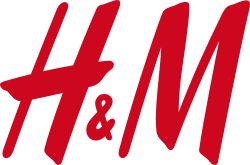This article contains promotional content .(April 2021) |
 | |
| H&M | |
| Company type | Public |
| Nasdaq Stockholm: HM B OMX Stockholm 30 | |
| ISIN | SE0000106270 [1] |
| Industry | Retail |
| Founded | 1947 (as Hennes) Västerås, Sweden |
| Founder | Erling Persson |
| Headquarters | , Sweden |
Number of locations | 4,338 stores (2024) [2] |
Area served | Worldwide |
Key people | Karl-Johan Persson (chairman) Daniel Erver (CEO and president) [3] |
| Products | Clothing Accessories |
| Brands |
|
| Revenue | |
| Total assets | |
| Total equity | |
| Owner | Stefan Persson (36%) |
Number of employees | 140,000 [a] (2024) |
| Website | hm.com (retail) hmgroup.com (corporate) |
| Footnotes /references [7] [8] [9] [10] | |
H & M Hennes & Mauritz AB, commonly known by its brand name H&M, is a Swedish multinational fast fashion retailer headquartered in Stockholm. Known for its fast fashion business model, H&M sells clothing, accessories, and homeware. The company has a significant global presence, operating thousands of stores across 75 geographical markets and employing over 171,000 people worldwide. [11]
Contents
- History
- Foundation
- Home furnishings
- Other brands
- Store openings worldwide
- COVID-19
- Withdrawal from the Russian market (2022)
- Supplies
- Corporate affairs
- Designers
- Sustainability and environmental awareness
- Used garment vouchers
- Endangered forests
- The H&M Foundation
- Brazilian leather halt
- Sustainability ambassador hiring
- Rental clothing
- Use of feathers
- Wool from mulesed sheep
- Concept stores
- Six concept brands
- H&M Details
- Labor practices
- Working conditions
- Supply chain transparency
- Slave and child labour
- Factory building structural collapses
- Living wage
- Fire safety report
- Xinjiang region
- Controversies
- Boycotts by China
- Greenwashing claims
- Leaving Russia
- Israel
- Australia
- Other controversies
- See also
- Notes
- References
- Further reading
- External links
H&M is the second-largest international clothing retailer after Inditex. [12] [13] H&M was founded by Erling Persson in 1947 under the name Hennes. The CEO of H&M from 2020 to 2024 was Helena Helmersson. The current CEO, as of January 2024, is Daniel Ervér. [14] [15] [16]






